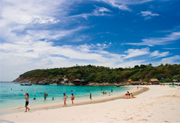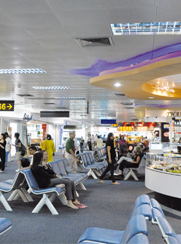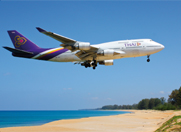Phuket has quietly positioned itself as an alternative gateway to Bangkok and the long-term strategy is beginning to pay off.
Its gateway status stregthens its ranking as one Asia’s most attractive island destinations capable of attracting the world most discerning travellers.

And hard passenger traffic statistics also confirm its right to be called Thailand’s second aviation gateway after Bangkok’s Suvarnabhumi Airport, offering travellers an alternative starting point for a memorable holiday exploring Thailand. A practical itinerary can include visits to destination far and wide without the need to transit or double back through the Thai capital.
This enviable status has crept up on the island’s tourism industry with very little fanfare, possibly as the island came of age across a variety of travel related business sectors.
Certainly the island’s appeal has broadened beyond hotels and boat trips to reach out to the long-stay luxury property market, yacht marinas, world class golf courses and even hosting regional exhibitions and international sports events.

It could also be attributed to the fact that well over 50% of Thailand’s annual visitors are repeaters. Some of them have visited the country annually for a decade or more and make it their second home during the harsh European winter. Phuket is a favourite.
This particularly true in the Swedish market where a recent survey indicated that more than 10,000 Swedes had bought holiday homes in Thailand, mainly in Phuket and nearby resorts.
Phuket’s gradual evolution from a beach destination to a major international gateway to Thailand’s southern region was driven by airlines that saw the potential for traffic growth and had a vision. They include Air Berlin that serves the island from Germany with scheduled airline services. Air Australia, previously Strategic Airways, flies nonstop services from Australia. Today, Australians are the top visitors to the island, providing year-round business.

Qatar Airways pioneered services from the Middle East and this too has helped boost traffic to the island during the rainy season, often called the “green season” by enthusiastic travel executives.
This island destination has come a long way from those early days in the 1980s when it was served by a 40-seat Avro aircraft flown under the colours of the domestic airline Thai Airways.
Today, there are 51 airlines serving the island offering 683 flights a week from Asia and Europe. There are also 13 charters from China, India, Russia and Europe, totaling 64 flights a week. They supplement the scheduled airlines (342 scheduled international flights offered by 33 airlines) and pack the island’s 44,000 tourist-standard hotels from November through to March.
Five domestic airlines serve Phuket with 277 flights a week making it possible to fly to all major destinations in Thailand, either transiting through, Samui or Bangkok. One airline has gone as far as offering nonstop flights direct to popular destination in North Thailand. This trend will continue.

Showing considerably vision and faith in the island’s ability to be a gateway, Thai Air Asia bases aircraft at Phuket International Airport and offers services to cities in Asia.
This long-term commitment will pay big dividends because it addresses a customer need. They want to get to their favourite island or other destinations nearby as fast as possible without having to change aircraft in Bangkok.
AirAsia offers international flights from Phuket to five destinations: Singapore (seven flights weekly); Kuala Lumpur (28 flights weekly); Jakarta (three flights weekly) Hong Kong (seven flights weekly) and Bali (four flights weekly).
Thai AirAsia also offers domestic flights direct from Phuket to four major gateway cities in Thailand: Bangkok; Chiang Mai; Udon Thani and Ubon Ratchathani.
This underscores Phuket’s ability to host visitors for a holiday or corporate meeting, while making it practical for them to extend their visit with side trips to explore other destinations in Thailand.
Phuket’s travel industry identified this need early in the game and lobbied airlines to consider direct air links from the island to other tourist destinations in Thailand as well cities in Asia.
Initially it looked like a hard sell, but as Phuket expanded offering luxury holiday homes for long-stay visitors and made inroads into niche markets such as sports and medical tourism, it became apparent that it had the potential to become a tourism gateway independent of Bangkok.
Bangkok Airways has tested the concept by extending its services through Phuket to offer links to Samui and Trat province (home of Chang Island). It promotes itself as an airline offering Thailand’s top three island destinations; Phuket, Samui and Chang, all within the same network and with connecting services to Hong Kong, Singapore and points in India.
Even if the traveller decides overland travel is the way to go, Phuket is an ideal base for self-drive tours to visit mainland destinations such as Khao Lak, Phang Nga, Krabi and Trang on highways that are a pleasure to drive.
Expansion of its gateway role continues as Phuket International Airport welcomes new airline services from Seoul and Copenhagen during this high season.
Thai Airways International is offering nonstop services from Seoul to Phuket (three flights weekly) and from Copenhagen in Denmark, three weekly services.
Air China launched a mix of scheduled and charter services from Beijing to Phuket 18 November.
Silk Air offers four daily service from Singapore, while Malaysia Airlines offers twice daily services from Kuala Lumpur.
Out of Hong Kong, Dragon Air flies 10 services a week.
In Europe, Air Berlin leads with scheduled services from Berlin and Munich (three flights each).
There are hundreds of charter flights during the peak season that make Phuket International Airport one of the busiest resort airports in Asia, far exceeding the traffic going through Bali or the Maldives.
Some of the charters are:
• Fly Airlines routing from Novosibirsk and Kransnoyarsk (two flight weekly);
• Britannia Airways from Stockholm and Copenhagen (four flights weekly);
• My Travel Airways from Helsinki, Malmo, Gothenburg, Oslo, Copenhagen and Stockholm (11 flights weekly);
• Sunny Airways from Seoul (three flights weekly);
• Thomsonfly from Helsinki (two flights weekly);
• XL Airways from Paris (one flight weekly).
Phuket International Airport for the first nine-month of this year welcomed 41,838 aircrafts movements up 18.83% from 35,296 movements in 2010 with an increase in international aircraft movements of 24.54% from 16,840 to 20,972 movements during the same period.
This indicates the success of Phuket in international markets and its ability to sustain a steady business flow for airlines that invest in a new service.
The island is also a staging point for scuba diving tours that head for the clear waters and coral reef dive sites of Similan Islands. It is close enough to other attractive beach resort destinations such as the mainland’s Khao Lak and Krabi where there are attractive boutique hotels and wellness resorts all within 100 to 150 km of Phuket island. They are ideal destinations to visit on a self-drive holiday.
But Phuket has a variety of beaches. In fact there are 20 beaches strung along its west coast making it an island with a plenty of options. Each beach location has a resort village that has grown up over the years to offers a distinct atmosphere. Patong is the racy entertainment beach bustling with shops, bars and entertainment. To the south and north of this resort hub there are quieter beaches where communities offer a different take on the holiday experience. There are some noted for five-star hotels that are more likely to be hosting corporate seminars and golf events. Further south there are smaller bays that have created a coffee culture with walking streets and boutique shops.
Phuket has over 44,000 rooms in tourist class hotels and another nine hotels will open in 2012.
It welcomed 2,853,367 tourists in 2010 up 4.85% from 2,721,269 in 2009 with 2,380,709 were foreigners improved 9.65% from 2,171,238 in 2009. The top three suppliers were Australia (422,017), Russia (151,945) and UK (134,867).




